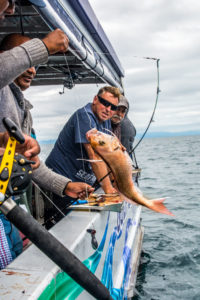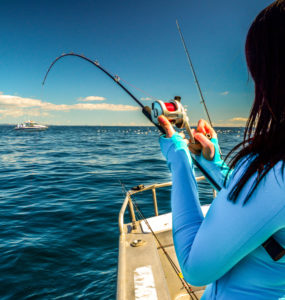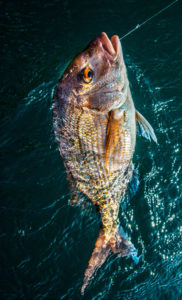Adjusting to the new reality – Sam Mossman
New Zealand Fishing News have kindly given FishCare permission to reproduce the following series of articles (originally published 2014)

New regulations for the SNA1 fishery (North Cape to East Cape) came into force, ironically, on April 1 (2014).
As most of you will be well aware, this involves a reduction in the bag limit for recreational fishermen from nine snapper down to seven and an increase in the minimum takeable size from 27cm up to 30cm. Regardless of the huge unfairness of this measure (when commercial have – yet again – had no quota reduction and are still able take snapper of 25cm, which have not even spawned once … don’t get me started!), these measures are the new reality and we will have to adjust if we are not to be turned into criminals.
One way to approach this – especially for inshore and land-based fishermen who live and breathe pannie snapper – is to adjust fishing methods and techniques to target bigger fish. Indeed, we have to catch bigger fish if we are to keep them for the table under the new regulations.
The upside to this situation is that if we can target bigger fish (albeit a few less of them) then we will probably end up with a similar actual weight of fish for the table as when we were catching more, but smaller fish.
But let’s get this straight: I’m not recommending going out and targeting the big old moochers here. To my mind, a top table fish ranges from a kilo up to about 4kg – fish of about 35-55cm in length. There are techniques to target the real XOS snapper – fish of say 9kg or more – but I rarely employ them these days. I figure these big old fish have earned their retirement and deserve to be left in peace, rather than in pieces. They have proven their survival instincts and growth potential by reaching a ripe old age and large size – these are the sort of fish we want in the gene pool. (READ MORE)
Fishing techniques and snapper survival
By Sam Mossman
 As most anglers will now be aware, some months ago the Minister of Primary Industries, Nathan Guy, made his pronouncement on reducing the SNA1 recreational bag limits and increasing the size limit.
As most anglers will now be aware, some months ago the Minister of Primary Industries, Nathan Guy, made his pronouncement on reducing the SNA1 recreational bag limits and increasing the size limit.
Predictably, no one is really happy with the result, and although (surprise, surprise) the commercial industry received no corresponding quota reduction to recreational cuts, there are some positives to come out of the decision regarding measures to try and control commercial fish dumping and juvenile mortality.
The devil is in the detail of course, and many aspects of the changes to commercial practices in SNA1 are short on actual nuts and bolts at this stage. For example, the ‘move-on rule’ will require commercial fishers to move from areas where “a significant portion of the catch is small juvenile fish”. But there is no definition of what a ‘significant portion’ is or what a ‘small juvenile fish’ is (especially considering that commercial are legally allowed to take 25cm fish, a size that most recreational fishermen would consider to be a small juvenile).
I guess we will see in due course how this, and the other new requirements on commercial boats to reduce wastage and juvenile mortality, actually work out. But with the new recreational regulations coming into force on April 1 – April Fools day ‑ it is timely to consider what might be done to reduce wastage and juvenile mortality in the recreational sector as well; after all, every bit helps.
Barbed wire
The hook type and size used is one aspect that can have a large effect on the survival of released fish – and those that are deep-hooked and undersized so must have the line cut and be returned; or break away and escape with a hook left in them. Researching this question I read a number of studies done on hook retention and fish mortality in the United States, Australia and New Zealand. (READ MORE)
Learning to let go ‑ handling and releasing snapper
Sam Mossman continues his series on minimizing snapper mortality as part of the ‘new reality’ in SNA1.

The term Noblesse oblige, roughly translated, means ‘with privilege comes responsibility’. Applied to fishing this concept can be interpreted that if we have the privilege of harvesting fish, so we have an obligation to look after them. Although it is questionable that many of those who see fish as a product and fishing as just a way to fatten their pockets have this principle at heart, I believe that more and more recreational anglers are accepting this precept.
Along with hook type and size (see last month’s feature), an important aspect of how anglers may help reduce mortality of released snapper ‑ and other fish ‑ is in the way in which they are handled prior to release.
The slime or mucus coating on the skin of a fish is its primary defence against infections. Avoiding damaging the mucus (slime) covering on the outside of the fish goes a long way to increasing the survival rates of returned fish.
Here, ‘best practice’ is less clear, but it is advisable to take a conservative approach. As an absolute minimum, wet your hands before touching fish and avoid putting fish on dry surfaces. Many consider that a wet rag, towel or cotton glove is a better way of holding fish for unhooking. Along with reducing damage to the fishes’ mucus covering, this gives a good grip (helping avoid dropping the fish) and also protects the handler from being cut by sharp scales, spines and gill plates. (READ MORE)


